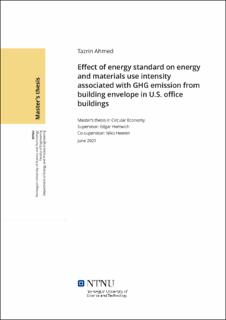| dc.description.abstract | Studies have shown that the existing building stocks consume about 40% of the energy and resources around the world. They are also responsible for one-third of the total global greenhouse gas (GHG) emissions. Commercial buildings, among others, consume a relatively higher amount of energy that eventually adds up to a significant amount of life cycle greenhouse gas (GHG) emission that translates into high global warming potential (GWP). The rapid growth of commercial building stock observed through the past few decades in the U.S. impose great demand on the energy sector, which calls for urgent measures for improvement. The U.S. Department of Energy (DOE) supported several programs to improve energy use in buildings through standards and laws which provide benchmark values for different types of buildings. Energy standards were developed by the American Society for Heating, Refrigerating, and Air-conditioning Engineers (ASHRAE). It proposes benchmark values for energy use per floor area and observes the energy performance of existing and new buildings in different states.
While energy standard-specific improvements offer potential savings for energy consumption and GHG emission, they often fail to address the role of materials associated with achieving these benchmarked values. Therefore, in this thesis, the impacts of materials used in the building envelop envelope (i.e., exterior wall and window) are thoroughly studied in relation to the most advanced ASHRAE 90.1-2019 energy standards. For this purpose, two types of office buildings, large and medium, with an area of are considered. Relation between energy and material use is studied by altering location, geometric composition, material, and construction type per components used in the building envelope.
Theoretic materials used in Pacific Northwest National Laboratory (PNNL) developed models are used as a reference to compare alternative materials. The two alternative models are created using cross-laminated timber and steel framed concrete with cavity insulation as exterior wall material. Both types of office buildings are modeled using two types of curtain wall materials. The model with steel-framed concrete wall uses a curtain wall with Low-E double-paned glass and aluminum mullions. And the cross-laminated timber wall model uses a curtain wall with reflexive double-paned glass and wooden mullion. The locations are selected based on the commitment to adapt energy standards in growing U.S. cities. Four cities, namely New York City, Buffalo, Seattle, and Honolulu, are selected for their distinct climatic characteristics.
Energy models for these buildings are primarily built in EnergyPlus version 9.2.0 energy simulation software. The environmental performance is exclusively assessed in terms of global warming potentials (GWP), expressed in kgCO2e, for energy (kWh) and material (kg) use per 1 m2 of gross floor area in a year. The environmental performance is conducted according to the life cycle assessment method for buildings. The results from energy simulation and GWP are also compared using different versions of energy standards in different climatic regions
Results show that, with changing wall and window ratio in the exterior wall, materials demand per square meter floor area either doubled or halved. Increased window area halved material demand for the wall material, and decreased window area doubled this demand. Among the two alternatives, the cross-laminated timber wall system required less amount of material compared to the steel-framed concrete with a cavity insulation system.
In terms of annual energy use intensity (EUI), large and medium office results range between 156 to 192 kWh/m2, and 80 to 116 kWh/m2, respectively. The material use intensity (MUI) for the large office envelop system in the large office building ranges between 23 to 105 kg/m2. The lowest and highest value corresponds with WWR of 90% and 20% respectively. For medium office envelop, MUI ranges between 21 to 150 kg/m2. The lowest and highest values come from envelops with WWR of 70% and 15%, respectively.
The total GWP from energy use and materials fluctuated among the locations, building type, and material. The GWP ranges between 50 and 173 kg CO2e/m2 for the large office building. In comparison, the range varied to 30 and 254 kg CO2e/m2 for medium office. The main driving factors were location, WWR, and materials used in the envelope. In all scenarios, the lowest and highest values are associated with Seattle and Honolulu, respectively. Office buildings in New York City and Buffalo show similar moderate performance in all cases.
In terms of ASHRAE 90.1 energy standard proposed benchmarks, the latest 2019 version suggests the most ambitious criteria for materials to achieve the best performance in new buildings. When comparing with older versions, it provides up to 30% energy and emissions saving compared to the 2007 version and 9% compared to the 2016 version for large office buildings. In medium offices, potential saving reaches up to 49% for the 2007 version and 15% for 2016. With constant office building stock growth in New York City, compared to the 2016 version, ASHRAE 90.1-2019 energy standard has the potential to reduce 5373 GJ energy demand which associates with GWP of 1495 Mg CO2e.
Results from the analysis show a positive impact of the ASHRAE 90.1-2019 energy standards. The expected savings in growing office building stock in the U.S. depends greatly on the commitment of the stakeholders involved in the governance, construction, and use of these buildings. It also depends on national strategy on the transition to a fossil-free energy system. A fossil-free energy mix and biobased construction material use will contribute to significantly low GWP, while the opposite is expected from the fossil-based and carbon-intensive conventional building material.
Key Words: U.S. Office building; ASHRAE 90.1-2019 energy standard; building envelope; alternative construction material; LCA; GWP | |
